"Vision is not enough, it must be combined with venture. It is not enough to stare up the steps, we must step up the stairs." -Vaclav Havel
It's arguable that vision is the most important tool that an astronomer can have. This was particularly important back before the invention of the telescope, as the greatest astronomers of their time (like Tycho Brahe) were renowned for their visual acuity.

How do you stack up? You were curious about learning how good your hearing was, but what about your vision? Well, you can always get your vision tested using a Snellen eye chart, and read the bottom-most line that you can at the appropriate distance.
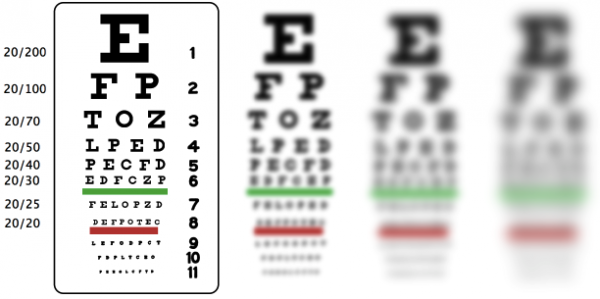
But where's the fun in that? And who wants to bother with an eyechart and measuring the proper distance?
Why not just use the astronomical objects available in the sky? You know, like this guy.

The Moon takes up about half-a-degree on the sky. In astronomy, we divide up each degree into 60 minutes of arc (known as arc-minutes), and we divide each minute up into 60 seconds of arc (known as arc-seconds).
Visible during the day or at night, the Moon is always -- except to those with awful vision -- very clearly a disc. A typical human being with "normal" vision (called 20/20 in the US) can see all the way down to resolutions of one arc minute, whereas the Moon, even at its smallest, appears to take up a whopping 29 arc minutes on the sky. Which, of course, is why we can see features on the Moon -- such as its phase and its great light-and-dark spots -- with our naked eyes!

But some people can see even better than average.
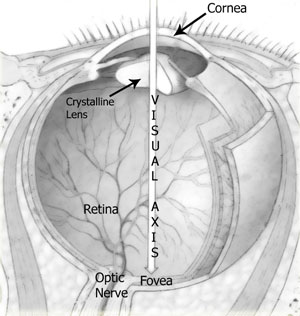
Laser interferometry -- despite that this runs contrary to what wikipedia tells you -- places a limit on what the perfect human eye (but still with rods & cones, sorry, Geordi La Forge) can see: down to a resolution of just 24 arc seconds, or 0.4 arc minutes. (This is the equivalent of 20/8 vision.)
It turns out that, for someone of just average vision, everything in the night sky that isn't the Moon will look like a single bright point of light.
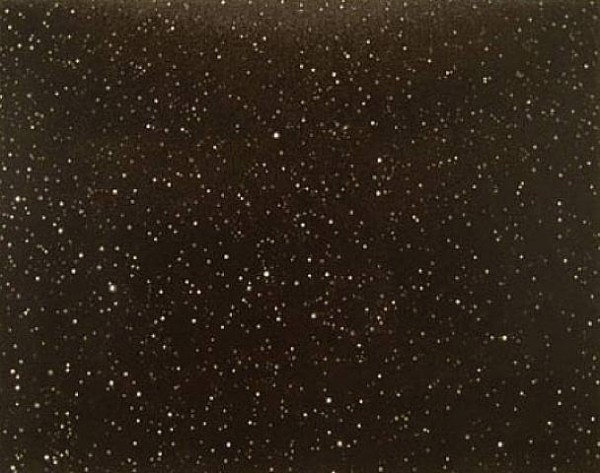
But is your vision better than average? (For those of you with eyeglasses/contacts, you can ask whether your corrected vision is better than average!) You see, there are two planets in our Solar System that -- during the right time of the year -- you could see as a disc instead of as a point, if your vision is good enough! How does this work?
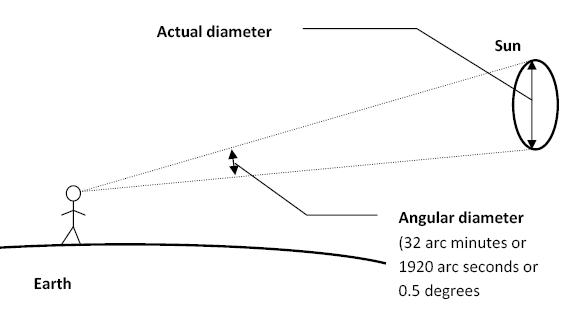
Planets -- although far away -- also have significant diameters. So long as they aren't too far away for how large they are, it should be possible for your eye to resolve that a planet is a disc, rather than a single point of light. In astronomy, we refer to this as the angular diameter of an object.
So which are the planets that we can do this with?

Say hi to Venus. At its dimmest, Venus appears brighter than even the brightest star. As far as distances go, Venus gets closer to Earth than any other planet; she sometimes passes within 40 million kilometers of Earth! When Venus is this close, someone with normal vision can just barely see Venus appear as a disc, rather than as a point. (It reaches a maximum angular size of 1 arc-minute and 6 arc-seconds.)
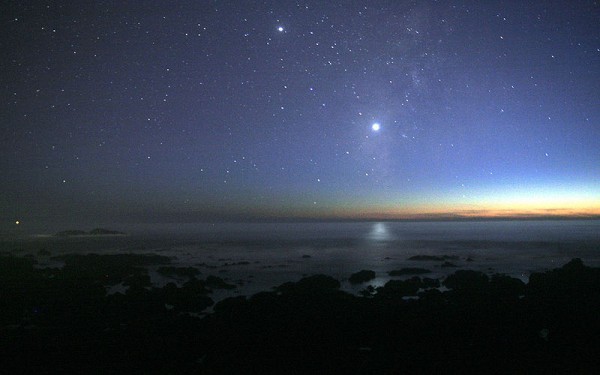
But Venus also gets far away from the Earth, falling all the way down to a minimum angular diameter of just over 9 arc-seconds, impossible to resolve for even a perfect human. Still, if you're meticulous, and you can see Venus as a disc on some nights but not on others, you can figure out what the limit of your vision is.
But there's another planet that's even better for this.
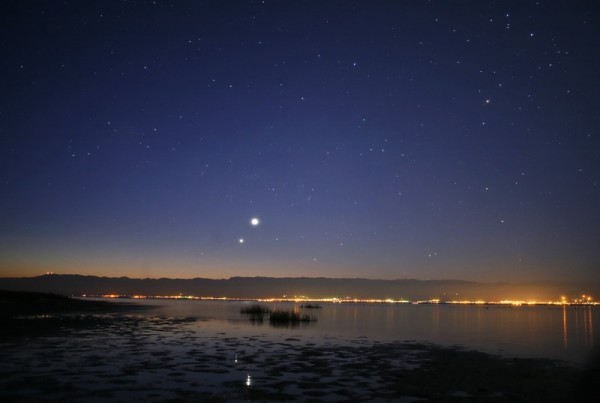
Also visible to the naked eye -- but not to everyone -- is the planet Jupiter, shown here as it was in 2008, just 2 degrees away from Venus! (Venus is the larger one.) Jupiter, when it's closest to Earth, appears to take up 50 arc-seconds on the sky. In other words, you can see it as a disc if your vision is slightly above average (about 20/16 vision), but not if your vision is only average!
But Jupiter also gets more than 300 million kilometers farther away from Earth, and when it's at its farthest it only takes up 29.8 arc-seconds, meaning that someone with 20/9 vision can see it as a disc, but one with 20/10 or worse will see it as a mere point!
Why do I bring this up now?
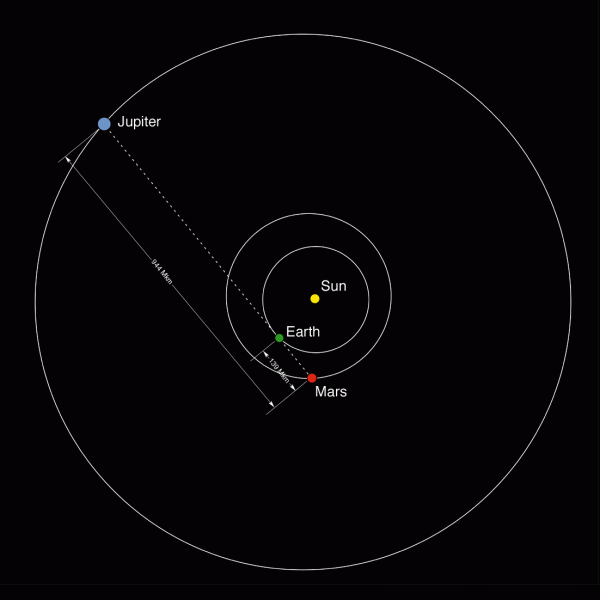
Because we are approaching "closest approach" to Jupiter! As the summer wears on, Jupiter will appear to get larger and larger, reaching its maximum size of 50 arc-seconds in September of this year (2010).
So if you can't see it as more than a point now, don't stop looking up! You could only be a few days away from seeing something that most people don't even know is possible! (Just make sure to wear your glasses, if you need them!)

This is very interesting. I never knew you could test your vision looking at planets! I must say, you did a pretty good job explaining everything.
I used to see Venus as a disc, but not anymore - the crescent Venus was pretty obvious to me once. :( My astigmatism is so bad now that the moon isn't round and a crescent moon has 3 images. These days Venus and Jupiter appear as smudges and any bright point of light (like Venus, Jupiter, or Sirius) has a halo due to scattering in the eye (easily distinguished from a genuine atmospheric halo because obscuring the light with a finger makes the halo disappear). I knew someone who had extraordinary vision though - since I didn't believe her I got her to read some text out of a book which I held at ~6m distance.
Well now i know my vision is pretty bad. I've never seen planets and my vision for stars is pretty dull too:(
Last time I saw Jupiter was the first time I'd ever seen it as a disc, rather than a spot. I have 9/6 vision with glasses (30/20 to the metrically challenged). I saw it at dusk, which I think helped. At night, it became a spot again. I guess that at dusk, I was using the cones in my eye, later on the rods. As I remember from my Uni days, the cones have better acuity.
I was horribly myopic as a kid, not getting glasses until I was ten. It was two years later, when I was outside at night and heard an airplane and looked up to see the flashing lights, that I saw stars for the first time in my life.
Optics rule! (As do large monitors.) I once slept under the stars in remote West Texas and just started looking up into the vast clear sky full of stars. The longer I looked, the more stars I could make out until it seemed like it would be easy to conclude that the sky had no dark areas at all, but was full of stars between stars. At some point this effect may have become just an illusion having only my 20/20 corrected vision at hand, but it now seems to be the same thing that Hubble deep shows, a relative infinity of stars anywhere you look.
And if you want to see Jupiter to do this test you'll have to get up about an hour before sunrise and look east-southeast.
thx i shud better leave this computer if have to watch that.
my eyesight is already below average
x__d
Nice.
Has anyone analyzed the observations of ancient astronomers (e.g. Pythagoras or the Mayans)or even Brahe or Kepler to determine whether their eyesight was better than average and if so by how much? I mean, was a contributing factor to Brahe's excellent data or to the Mayans great calendar that they had excellent vision?
Oops. I see Ethan answered my question in his first paragraph.
Regarding the maximum resolving power of the human eye, a fun exercise for an intro. physics class is to estimate the diffraction limit of the human eye based on an estimate of the diameter of the pupil and the wavelength of visible light.
Then draw two pairs of thick lines on a piece of paper: one pair with a small gap between them, one pair with no gap between them.
Have the students walk back and forth to determine the location where they can no longer distinguish the two pairs of lines. Within a factor of 2 or so, it usually agrees pretty well with the diffraction limit.
Some of the pictures of the sky are beautiful! Great read!
I just tried this test and have to say that I'm pretty impressed by it. I still remember some of the things from Astronomy class but this is already a long time ago. Thanks for lettings us know about it. Jessica from traumpartner finden team. I will also suggest it to my friends, I'm sure they will love it.
i am 14 and i want to be an astronomer and im ok in science, what else does it take?
Hi Ethan, I'm trying to locate the context of the quote by Havel you made in the beginning. Therefore, I'm looking for the source of this sentence (where has he written or said it?) Since most of what he said or wrote was in Czech, but the sentence uses an English wordplay, I want to find out how and where and in which context he said or wrote it. Do you have a source for that sentence? (And I don't mean an online quotation collection...) Thanks